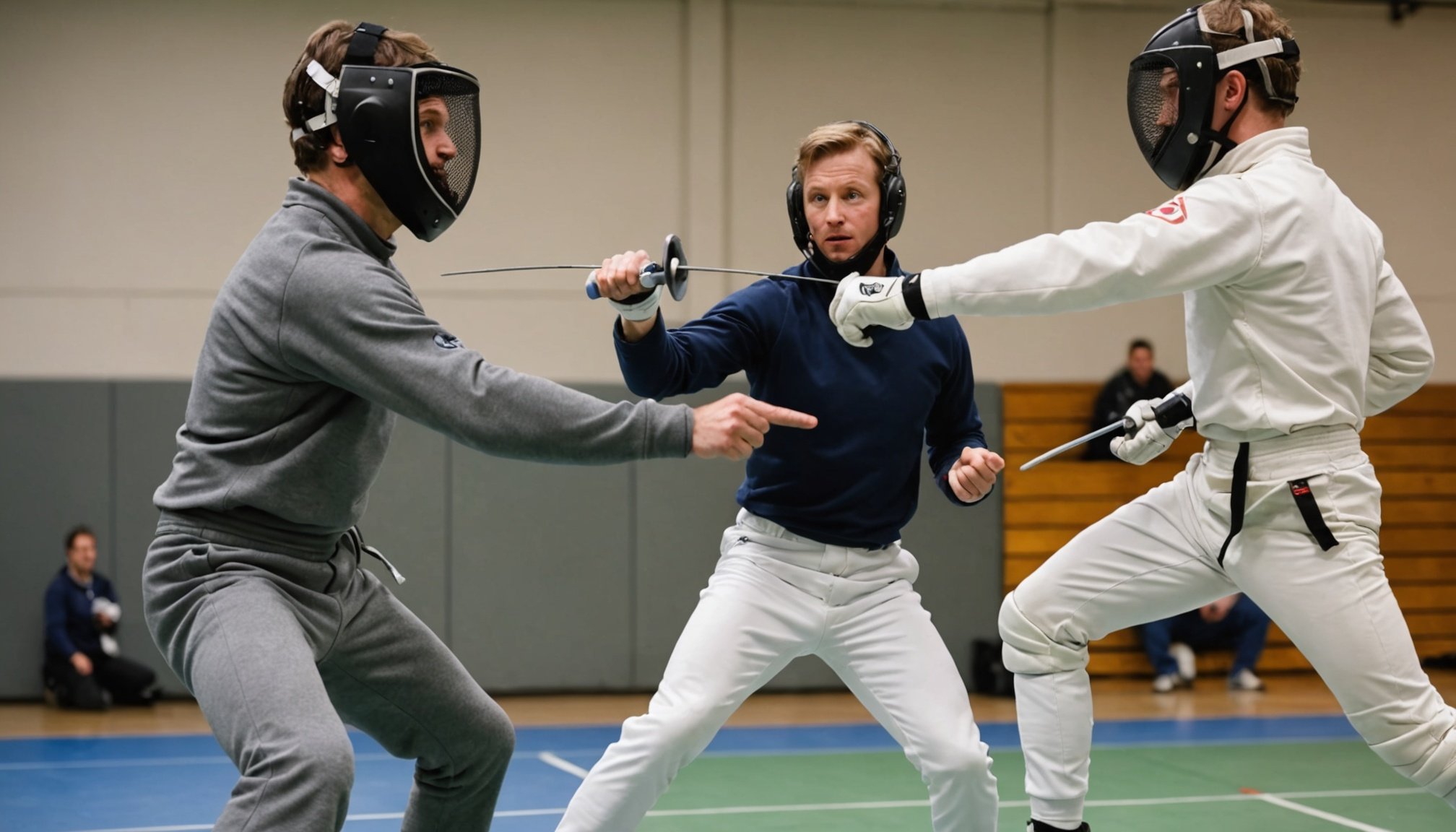Understanding Reaction Times in Fencing
In the world of fencing, reaction time stands as a pivotal element defining success. It’s the brief span between a fencer recognising an opponent’s move and responding to it. This agility can significantly influence a fencer’s performance, as every fraction of a second counts in deciding outcomes. Athletic agility in fencing relies heavily on these swift mental processes translating into precise physical actions.
Scientific studies emphasize reaction time as crucial in combat sports. Research underlines that faster reaction times can dramatically improve a fencer’s offensive and defensive capabilities. This correlation highlights how mental processes directly impact the effectiveness of physical reactions in fencing.
Also to see : Top Proven Techniques to Combat Heat Stress in Endurance Athletes
Furthermore, as fencing is a sport involving rapid movements and split-second decisions, developing a shorter reaction time can be as crucial as mastering technical skills. The interplay between mental acuity and physical agility is what often sets apart extraordinary fencers. To enhance fencing performance, athletes frequently engage in specific training exercises designed to boost both quick decision-making and execution speed.
Ultimately, the science of reaction times underscores its critical role in defining athletic agility. This scientific backing provides valuable insights into personalised training regimes that could help fencers refine their competitive edge.
This might interest you : Top Recovery Strategies to Combat Muscle Fatigue in Ultracycling: Your Ultimate Guide
Tactical Training Techniques for Enhancing Reaction Times
Improving reaction times is crucial for success in tactical sports. Drills for fencers enhance both speed and precision.
Warm-Up Drills
Dynamic warm-ups are key in preparing your body and mind for optimal reaction time improvement. Prioritising exercises targeting quick reflexes helps make later drills more effective. A blend of jogging, dynamic stretching, and agility ladders is recommended. These activities increase heart rate, improve circulation, and stimulate neural pathways.
To benefit fully, these warm-ups should be practiced consistently, lasting at least 15 to 20 minutes, preferably before each training session. The frequency of these sessions greatly influences the response speed, laying a strong foundation for more intense drills.
Reaction Time Drills
Reaction time drills focus on sensory engagement. Visual drills often involve identifying and responding to light signals. Auditory drills might include responding to patterned sounds. Combining visual and auditory cues introduces complexity, enhancing alertness.
Detailed Steps for a Visual Drill:
- Use a light board with multiple bulbs.
- The goal is to touch the light that appears as quickly as possible.
- Repeat with increased speed and varied patterns.
Skill levels dictate necessary variations, from solo practices to competitive settings. As precision increases, the drills should become more intricate, aiming for continuous improvement.
Mental Agility and Its Role in Reaction Times
Mental agility is an essential component in sports that require quick reaction times, such as fencing. The link between mental readiness and physical reaction is profound. When an athlete is mentally prepared, they can process information faster, enabling swifter responses. This has a direct impact on their performance, enhancing their ability to anticipate and react to their opponent’s moves.
Cognitive training exercises play a crucial role in improving mental agility. These exercises are designed to enhance brain functions such as memory, attention, and processing speed. For instance, activities like puzzles, memory games, or dual-task exercises can significantly sharpen an athlete’s mental agility. Regular engagement in such exercises helps athletes to think faster and make decisions more quickly during competitions.
Maintaining focus in fencing is vital for success. Fencers can benefit from developing techniques to enhance concentration during matches. Setting aside time for mindfulness or meditation can improve an athlete’s focus, enabling them to better assess and react to their opponent. Additionally, practicing rhythmic breathing or visualization techniques before a match can further heighten their state of readiness.
By integrating consistent cognitive training and strategies to maintain focus, athletes can markedly improve their reaction times, ultimately enhancing their performance in high-pressure scenarios.
Cross-Training for Enhanced Performance
Incorporating a variety of cross-training benefits can significantly enhance your performance as a fencer. By engaging in agility training and exploring complementary sports, fencers can improve their skills and reaction times.
Sports that Improve Fencing Reaction Times
Choosing the right complementary sports can bolster a fencer’s reaction times. Sports like squash or table tennis require quick reflexes and can effectively transfer these skills to fencing. Participating in such sports provides vital skills like anticipation, hand-eye coordination, and swift directional changes. Balancing time between fencing and these sports ensures each receives adequate attention, fostering comprehensive development.
Incorporating Agility Exercises
Agility training is pivotal for fencers aiming to enhance their speed and responsiveness. Recommended drills include ladder exercises, cone drills, and shuttle runs. Fencers should aim to integrate these exercises into their routines two to three times a week for optimal results. Carefully scheduling these sessions ensures they complement regular fencing practice without causing burnout.
Monitoring progress is crucial. Keep track of improvements by timing drills, noting changes in reaction times, and adjusting the intensity based on performance. By prioritizing agility training, fencers cultivate quick, adaptable movements that give them an edge in competition.
Evaluating Progress and Adjusting Training
Assessing an athlete’s advancement involves meticulously tracking improvements in reaction time. This is pivotal in tailoring training regimens effectively. One effective method includes regular performance assessment sessions, where athletes’ response speeds are measured under simulated game conditions. This allows for a direct comparison to previous metrics, showcasing tangible improvements or identifying areas for enhancement.
Consistent feedback from coaches plays a critical role in fostering progression. Constructive coaching feedback not only highlights areas needing improvement but also reinforces successful techniques. This two-way communication is essential in maintaining motivation and ensuring athletes are on the right path towards their goals.
Adjusting drills according to each athlete’s individual progress and needs is crucial. Coaches may need to vary the intensity or type of drills based on real-time data gathered from performance assessments. For example:
- Introducing more complex scenarios after basic drills have been mastered.
- Altering rest periods to maintain optimal performance levels.
- Customising workouts to focus on specific weaknesses identified during evaluations.
By prioritising these adaptive strategies, athletes can experience continual growth and enhancement in their performance. This approach not only optimises training outcomes but also ensures that athletes remain engaged and motivated throughout their regimen.
Advanced Techniques and Innovations in Fencing Training
Striving for excellence in fencing demands not only physical prowess but also the use of advanced training techniques. Technology in sports has introduced a myriad of tools that enhance a fencer’s skill set. These tools range from digital scoring systems to motion-capture software, each contributing uniquely to the training ecosystem.
Utilizing Technology for Technique Improvement
Incorporating technology into training routines is pivotal for modern fencers. Whether through wearables or software applications, tech aids in perfecting stances, thrusts, and parries. An essential component is the use of video analysis, which allows athletes to review and refine their techniques with precision. Video feedback provides immediate, actionable insights, enabling fencers to adjust and evolve quickly.
Emerging Trends in Fencing Training
The landscape of fencing training constantly evolves, with innovative methods making headway. New drills focus on both speed and strategic thinking, sharpening both mind and reflexes. The role of mental training is also increasing, acknowledging that success in the sport is as much about mental acuity as physical agility. Looking ahead, fencing training will likely see an integration of artificial intelligence, providing tailored feedback and suggestions to propel athletes to new heights.
As these methods develop, they promise to push the boundaries of what fencers can achieve, offering endless possibilities for growth and improvement.






